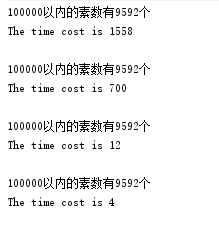java求质数的4种方法,
第一种:双重for循环 使除数与被除数个个计算,效率极低
public void test1(int n){ long start = System.currentTimeMillis(); //取开始时间 int num=0; boolean sign; for(int i=2;i<n;i++){ if(i % 2 == 0 && i != 2 ) continue; //偶数和1排除 sign=true; for (int j=2;j<i;j++){ if(i%j==0){ sign=false; break; } } if (sign){ num++; /* System.out.println(""+i);*/ } } System.out.println(n+"以内的素数有"+num+"个"); long end = System.currentTimeMillis(); System.out.println("The time cost is " + (end - start)); System.out.println(""); }
第二种:主要考虑2 ~ i/2之间的数 ,效率比第一种提高一半
public void test2(int n){ long start = System.currentTimeMillis(); //取开始时间 int num=0; int j; boolean sgin; for (int i = 2; i <= n; i++) { if(i % 2 == 0 && i != 2 ) continue; //偶数和1排除 sgin = true; for (j = 2; j <= i/2 ; j++) { if (i % j == 0) { sgin= false; break; } } //打印 if (sgin) { num++; /* System.out.println(""+i);*/ } } System.out.println(n+"以内的素数有"+num+"个"); long end = System.currentTimeMillis(); System.out.println("The time cost is " + (end - start)); System.out.println(""); }
第三种:使用开方去过滤 Math.sqrt(i)
public void test3(int n){ long start = System.currentTimeMillis(); //取开始时间 int num=0; int j; boolean sgin; for (int i = 2; i <= n; i++) { if(i % 2 == 0 && i != 2 ) continue; //偶数和1排除 sgin= true; for (j = 2; j <= Math.sqrt(i) ; j++) { if (i % j == 0) { sgin = false; break; } } //打印 if (sgin) { num++; /* System.out.println(""+i);*/ } } System.out.println(n+"以内的素数有"+num+"个"); long end = System.currentTimeMillis(); System.out.println("The time cost is " + (end - start)); System.out.println(""); }
第四种:逆向思维筛选质素,最为高效
public void test4(int n){ long start = System.currentTimeMillis(); //取开始时间 //素数总和 int sum = 0; //1000万以内的所有素数 //用数组将1000万以内的数分为两大派系,素数用0代替数值,合数用1代替数值; //一开始默认全部为素数,所以值全部为0,等到开始筛选的时候再把为合数的赋值为1 int num[] = new int[n]; num[0] = 1; //由于1规定不是素数,所以要提前用1标值 //根据埃氏筛法的结论,要得到自然数 N 以内的全部素数,必须把不大于" 二次根号 N "的所有素数的倍数剔除,剩下的就是素数 double prescription = Math.sqrt(n); for (int i = 2; i <= prescription; i++) { //开始把所有素数的倍数剔除,剩下的就是素数 for (int j = i*i; j <= n; j+=i) { //从i*i开始去除,因为比i*i小的倍数,已经在前面去除过了 //例如:i=5 //5的2倍(10),3倍(15),在i=2的时候,已经去除过了 num[j-1] = 1; //把素数的倍数剔除,也就是赋值为1,不是素数就是合数 } } //遍历数组,把值为0的数全部统计出来,得到素数之和 for (int i = 0; i < num.length; i++) { if(num[i]==0) sum++; } System.out.println(n+"以内的素数有"+sum+"个"); long end = System.currentTimeMillis(); System.out.println("The time cost is " + (end - start)); System.out.println(""); }
public static void main(String[] args) { Demo1 demo1 = new Demo1(); demo1.test1(100000); demo1.test2(100000); demo1.test3(100000); demo1.test4(100000); }
结果:
100000以内的素数有9592个
The time cost is 1558
100000以内的素数有9592个
The time cost is 700
100000以内的素数有9592个
The time cost is 12
100000以内的素数有9592个
The time cost is 4

备注:感谢前辈们提供的学习资源,前三种来自 :https://blog.csdn.net/u010503822/article/details/78734371 最后一种方式来自:http://how2j.cn/k/number-string/number-string-math/319.html#nowhere
如有冒犯或者错误请多多原谅





